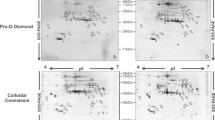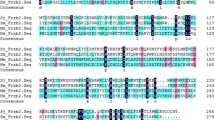Abstract
Schistosoma is the causative agent of schistosomiasis, a common infectious disease distributed worldwide. Our previous phosphoproteomic analysis suggested that glycogen synthase kinase 3 (GSK3), a conserved protein kinase in eukaryotes, is likely involved in protein phosphorylation of Schistosoma japonicum. Here, we aimed to identify the interacting partners of S. japonicum GSK3β (SjGSK3β) and to evaluate its role in parasite survival. Toward these ends, we determined the transcription levels of SjGSK3β at different developmental stages and identified its interacting partners of SjGSK3β by screening a yeast two-hybrid S. japonicum cDNA library. We further used RNA interference (RNAi) to inhibit the expression of SjGSK3β in adult worms in vitro and examined the resultant changes in transcription of its putative interacting proteins and in worm viability compared with those of control worms. Reverse transcription-quantitative polymerase chain analysis indicated that SjGSK3β is expressed throughout the life cycle of S. japonicum, with higher expression levels detected in the eggs and relatively higher expression level found in male worms than in female worms. By screening the yeast two-hybrid library, eight proteins were identified as potentially interacting with SjGSK3β including cell division cycle 37 homolog (Cdc37), 14-3-3 protein, tegument antigen (I(H)A), V-ATPase proteolipid subunit, myosin alkali light chain 1, and three proteins without recognized functional domains. In addition, SjGSK3β RNAi reduced the SjGSK3β gene transcript level, leading to a significant decrease in kinase activity, cell viability, and worm survival. Collectively, these findings suggested that SjGSK3β may interact with its partner proteins to influence worm survival by regulating kinase activity.





Similar content being viewed by others
References
Ali A, Hoeflich KP, Woodgett JR (2001) Glycogen synthase kinase-3: properties, functions, and regulation. Chem Rev 101(8):2527–2540
Cheng G, Luo R, Hu C, Lin J, Bai Z, Zhang B, Wang H (2013) TiO2-based phosphoproteomic analysis of schistosomes: characterization of phosphorylated proteins in the different stages and sex of Schistosoma japonicum. J Proteome Res 12(2):729–742. https://doi.org/10.1021/pr3007864
Cohen P, Alessi DR (2013) Kinase drug discovery--what’s next in the field? ACS Chem Biol 8(1):96–104. https://doi.org/10.1021/cb300610s
Colley DG, Bustinduy AL, Secor WE, King CH (2014) Human schistosomiasis. Lancet 383(9936):2253–2264. https://doi.org/10.1016/S0140-6736(13)61949-2
Droucheau E, Primot A, Thomas V, Mattei D, Knockaert M, Richardson C, Sallicandro P, Alano P, Jafarshad A, Baratte B, Kunick C, Parzy D, Pearl L, Doerig C, Meijer L (2004) Plasmodium falciparum glycogen synthase kinase-3: molecular model, expression, intracellular localisation and selective inhibitors. Biochim Biophys Acta 1697(1–2):181–196. https://doi.org/10.1016/j.bbapap.2003.11.023
Efstathiou A, et al. (2019) Indirubin analogues inhibit Trypanosoma brucei glycogen synthase kinase 3 short and T. brucei growth. Antimicrob Agents Chemother 63(6) doi:https://doi.org/10.1128/AAC.02065-18
Embi N, Rylatt DB, Cohen P (1980) Glycogen synthase kinase-3 from rabbit skeletal muscle. Separation from cyclic-AMP-dependent protein kinase and phosphorylase kinase. Eur J Biochem 107(2):519–527
Fabres A et al (2010) Effect of GSK-3 activity, enzymatic inhibition and gene silencing by RNAi on tick oviposition and egg hatching. Parasitology 137(10):1537–1546. https://doi.org/10.1017/S0031182010000284
Forgac M (2007) Vacuolar ATPases: rotary proton pumps in physiology and pathophysiology. Nat Rev Mol Cell Biol 8(11):917–929. https://doi.org/10.1038/nrm2272
Giuliani S, Silva AC, Borba JVVB, Ramos PIP, Paveley RA, Muratov EN, Andrade CH, Furnham N (2018) Computationally-guided drug repurposing enables the discovery of kinase targets and inhibitors as new schistosomicidal agents. PLoS Comput Biol 14(10):e1006515. https://doi.org/10.1371/journal.pcbi.1006515
Guyett PJ, Xia S, Swinney DC, Pollastri MP, Mensa-Wilmot K (2016) Glycogen synthase kinase 3beta promotes the endocytosis of transferrin in the African trypanosome. ACS Infect Dis 2(7):518–528. https://doi.org/10.1021/acsinfecdis.6b00077
Hoeflich KP, Luo J, Rubie EA, Tsao MS, Jin O, Woodgett JR (2000) Requirement for glycogen synthase kinase-3beta in cell survival and NF-kappaB activation. Nature 406(6791):86–90. https://doi.org/10.1038/35017574
Hotez PJ, Alvarado M, Basáñez MG, Bolliger I, Bourne R, Boussinesq M, Brooker SJ, Brown AS, Buckle G, Budke CM, Carabin H, Coffeng LE, Fèvre EM, Fürst T, Halasa YA, Jasrasaria R, Johns NE, Keiser J, King CH, Lozano R, Murdoch ME, O’Hanlon S, Pion SDS, Pullan RL, Ramaiah KD, Roberts T, Shepard DS, Smith JL, Stolk WA, Undurraga EA, Utzinger J, Wang M, Murray CJL, Naghavi M (2014) The global burden of disease study 2010: interpretation and implications for the neglected tropical diseases. PLoS Negl Trop Dis 8(7):e2865. https://doi.org/10.1371/journal.pntd.0002865
Hu W, Yan Q, Shen DK, Liu F, Zhu ZD, Song HD, Xu XR, Wang ZJ, Rong YP, Zeng LC, Wu J, Zhang X, Wang JJ, Xu XN, Wang SY, Fu G, Zhang XL, Wang ZQ, Brindley PJ, McManus DP, Xue CL, Feng Z, Chen Z, Han ZG (2003) Evolutionary and biomedical implications of a Schistosoma japonicum complementary DNA resource. Nat Genet 35(2):139–147. https://doi.org/10.1038/ng1236
Kimura Y, Rutherford SL, Miyata Y, Yahara I, Freeman BC, Yue L, Morimoto RI, Lindquist S (1997) Cdc37 is a molecular chaperone with specific functions in signal transduction. Genes Dev 11(14):1775–1785. https://doi.org/10.1101/gad.11.14.1775
Lee SK, et al. (2018) Beta-catenin-RAS interaction serves as a molecular switch for RAS degradation via GSK3beta. EMBO Rep 19(12) https://doi.org/10.15252/embr.201846060
Lewis FA, Stirewalt MA, Souza CP, Gazzinelli G (1986) Large-scale laboratory maintenance of Schistosoma mansoni, with observations on three schistosome/snail host combinations. J Parasitol 72(6):813–829
Liu J, Giri BR, Chen Y, Cheng G (2019) 14-3-3 protein and ubiquitin C acting as SjIAP interaction partners facilitate tegumental integrity in Schistosoma japonicum. Int J Parasitol 49(5):355–364. https://doi.org/10.1016/j.ijpara.2018.11.011
Liu J, Giri BR, Chen Y, Luo R, Xia T, Grevelding CG, Cheng G (2018) Schistosoma japonicum IAP and Teg20 safeguard tegumental integrity by inhibiting cellular apoptosis. PLoS Negl Trop Dis 12(7):e0006654. https://doi.org/10.1371/journal.pntd.0006654
Livak KJ, Schmittgen TD (2001) Analysis of relative gene expression data using real-time quantitative PCR and the 2(−Delta Delta C(T)) method. Methods 25(4):402–408. https://doi.org/10.1006/meth.2001.1262
Luo R, Zhou C, Lin J, Yang D, Shi Y, Cheng G (2012) Identification of in vivo protein phosphorylation sites in human pathogen Schistosoma japonicum by a phosphoproteomic approach. J Proteome 75(3):868–877. https://doi.org/10.1016/j.jprot.2011.10.003
Martin M, Rehani K, Jope RS, Michalek SM (2005) Toll-like receptor-mediated cytokine production is differentially regulated by glycogen synthase kinase 3. Nat Immunol 6(8):777–784. https://doi.org/10.1038/ni1221
Masch A, Kunick C (2015) Selective inhibitors of Plasmodium falciparum glycogen synthase-3 (PfGSK-3): new antimalarial agents? Biochim Biophys Acta 1854(10 Pt B):1644–1649. https://doi.org/10.1016/j.bbapap.2015.03.013
Mury FB et al (2016) Glycogen synthase kinase-3 is involved in glycogen metabolism control and embryogenesis of Rhodnius prolixus. Parasitology 143(12):1569–1579. https://doi.org/10.1017/S0031182016001487
Narasimhan G, Henderson J, Luong HT, Rajasekaran NS, Qin G, Zhang J, Krishnamurthy P (2019) OBG-like ATPase 1 inhibition attenuates angiotensin II-induced hypertrophic response in human ventricular myocytes via GSK-3beta/beta-catenin signalling. Clin Exp Pharmacol Physiol 46(8):743–751. https://doi.org/10.1111/1440-1681.13101
Nusse R et al (1997) Cell culture and whole animal approaches to understanding signaling by Wnt proteins in Drosophila. Cold Spring Harb Symp Quant Biol 62:185–190
Ojo KK, Gillespie JR, Riechers AJ, Napuli AJ, Verlinde CLMJ, Buckner FS, Gelb MH, Domostoj MM, Wells SJ, Scheer A, Wells TNC, van Voorhis WC (2008) Glycogen synthase kinase 3 is a potential drug target for African trypanosomiasis therapy. Antimicrob Agents Chemother 52(10):3710–3717. https://doi.org/10.1128/AAC.00364-08
Pearl LH, Prodromou C (2006) Structure and mechanism of the Hsp90 molecular chaperone machinery. Annu Rev Biochem 75:271–294. https://doi.org/10.1146/annurev.biochem.75.103004.142738
Plyte SE, Hughes K, Nikolakaki E, Pulverer BJ, Woodgett JR (1992) Glycogen synthase kinase-3: functions in oncogenesis and development. Biochim Biophys Acta 1114(2–3):147–162. https://doi.org/10.1016/0304-419x(92)90012-n
Qin CL, Tang J, Kim K (1998) Cloning and in vitro expression of TPK3, a Toxoplasma gondii homologue of shaggy/glycogen synthase kinase-3 kinases. Mol Biochem Parasitol 93(2):273–283
Rahman MK, You M (2019) Molecular cloning and transcriptional and functional analysis of glycogen synthase kinase-3beta in Haemaphysalis longicornis (Acari, Ixodidae). Parasite 26:39. https://doi.org/10.1051/parasite/2019038
Rask-Andersen M, Zhang J, Fabbro D, Schioth HB (2014) Advances in kinase targeting: current clinical use and clinical trials. Trends Pharmacol Sci 35(11):604–620. https://doi.org/10.1016/j.tips.2014.09.007
Rayasam GV, Tulasi VK, Sodhi R, Davis JA, Ray A (2009) Glycogen synthase kinase 3: more than a namesake. Br J Pharmacol 156(6):885–898. https://doi.org/10.1111/j.1476-5381.2008.00085.x
Swinney ZT, Haubrich BA, Xia S, Ramesha C, Gomez SR, Guyett P, Mensa-Wilmot K, Swinney DC (2016) A four-point screening method for assessing molecular mechanism of action (MMOA) identifies Tideglusib as a time-dependent inhibitor of Trypanosoma brucei GSK3beta. PLoS Negl Trop Dis 10(3):e0004506. https://doi.org/10.1371/journal.pntd.0004506
Wang H, Kumar A, Lamont RJ, Scott DA (2014) GSK3beta and the control of infectious bacterial diseases. Trends Microbiol 22(4):208–217. https://doi.org/10.1016/j.tim.2014.01.009
Wang JR, Sun PH, Ren ZX, Meltzer HY, Zhen XC (2017) GSK-3beta interacts with dopamine D1 receptor to regulate receptor function: implication for prefrontal cortical D1 receptor dysfunction in schizophrenia. CNS Neurosci Ther 23(2):174–187. https://doi.org/10.1111/cns.12664
Woo Y, Kim SJ, Suh BK, Kwak Y, Jung HJ, Nhung TTM, Mun DJ, Hong JH, Noh SJ, Kim S, Lee A, Baek ST, Nguyen MD, Choe Y, Park SK (2019) Sequential phosphorylation of NDEL1 by the DYRK2-GSK3beta complex is critical for neuronal morphogenesis. Elife 8. https://doi.org/10.7554/eLife.50850
Woodgett JR (1990) Molecular cloning and expression of glycogen synthase kinase-3/factor A. EMBO J 9(8):2431–2438
Xingi E, Smirlis D, Myrianthopoulos V, Magiatis P, Grant KM, Meijer L, Mikros E, Skaltsounis AL, Soteriadou K (2009) 6-Br-5methylindirubin-3'oxime (5-Me-6-BIO) targeting the leishmanial glycogen synthase kinase-3 (GSK-3) short form affects cell-cycle progression and induces apoptosis-like death: exploitation of GSK-3 for treating leishmaniasis. Int J Parasitol 39(12):1289–1303. https://doi.org/10.1016/j.ijpara.2009.04.005
Zhang H, Burrows F (2004) Targeting multiple signal transduction pathways through inhibition of Hsp90. J Mol Med (Berl) 82(8):488–499. https://doi.org/10.1007/s00109-004-0549-9
Zhou XN, Wang LY, Chen MG, Wu XH, Jiang QW, Chen XY, Zheng J, Jürg U (2005) The public health significance and control of schistosomiasis in China--then and now. Acta Trop 96(2–3):97–105. https://doi.org/10.1016/j.actatropica.2005.07.005
Zhou Y et al (2009) The Schistosoma japonicum genome reveals features of host–parasite interplay. Nature 460(7253):345–351. https://doi.org/10.1038/nature08140
Funding
This study was, in part or in whole, supported by the National Natural Science Foundation of China (31472187 and 31672550) and the Agricultural Science and Technology Innovation Program of the Chinese Academy of Agricultural Sciences.
Author information
Authors and Affiliations
Corresponding author
Ethics declarations
All animal experiments were carried out strictly following the guidelines for animal use with approval from Shanghai Laboratory Animal Management Committee and the Animal Care and Use Committee of Shanghai Veterinary Research Institute, Chinese Academy of Agricultural Sciences (permit number: SYXK 2016-0010).
Conflict of interest
The authors declare that they have no competing interests.
Additional information
Section Editor: Xing-Quan ZHU
Publisher’s note
Springer Nature remains neutral with regard to jurisdictional claims in published maps and institutional affiliations.
Electronic supplementary material
ESM 1
Evaluation of the self-activation of pBT3SUC-SjGSK3β plasmid. NMY32 yeast cells were transformed with different combinations of plasmids, including pNubG-Fe65 + pTSU2-APP (positive control, lane 1), pPR3N + pTSU2-APP (negative control, lane 2), pPR3N + pBT3SUC-SjGSK3β (self-activation, lane 3) and pOST1-NubI + pBT3SUC-SjGSK3β (functional evaluation, lane 4) and cultured on SD-Trp-Leu (SD-TL), SD-Trp-Leu-His (SD-TLH), and SD-Trp-Leu-His-Ade (SD-TLHA) agars plates. The number of colonies was counted. (PNG 817 kb)
ESM 2
β-galactosidase assay for colonies obtained by screening the yeast two hybrid library using pBT3SUC-SjGSK3β as the bait plasmid. A total of 34 colonies that grew on SD-TL agar were inoculated in SD-TL liquid medium and cultured for the β-galactosidase assay. The β-galactosidase activity was measured according to the optical density (OD) 615 nm and 546 nm and calculated as the OD615/OD546 ratio. (PNG 384 kb)
ESM 3
β-galactosidase assay for yeast cells containing bait plasmid transformed with prey plasmids. NYM32 yeast cells containing the pBT3SUC-SjGSK3β bait plasmid were transformed with 15 prey plasmids and cultured on SD-TL agar. Fifteen colonies that grew on SD-TL agar were inoculated in SD-TL liquid medium and cultured for the β-galactosidase assay. The β-galactosidase activity was measured based on the optical density (OD) 615 nm and 546 nm and calculated as the OD615/OD546 ratio. (PNG 238 kb)
ESM 4
(DOCX 14 kb)
Rights and permissions
About this article
Cite this article
Liu, J., Li, H., Xia, T. et al. Identification of Schistosoma japonicum GSK3β interacting partners by yeast two-hybrid screening and its role in parasite survival. Parasitol Res 119, 2217–2226 (2020). https://doi.org/10.1007/s00436-020-06731-2
Received:
Accepted:
Published:
Issue Date:
DOI: https://doi.org/10.1007/s00436-020-06731-2




